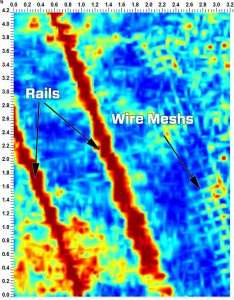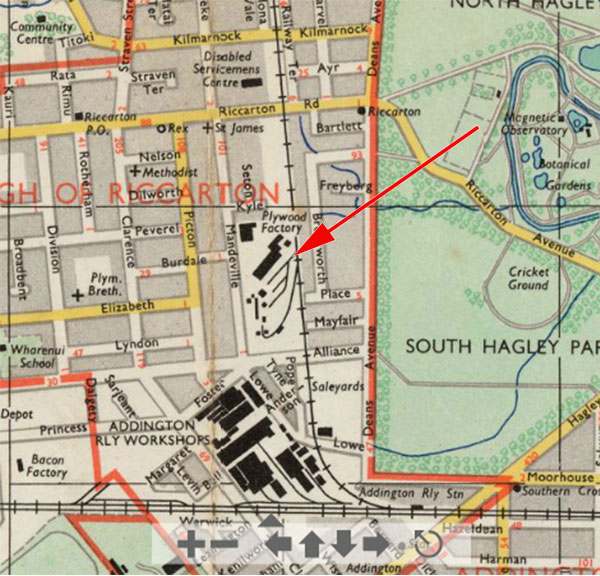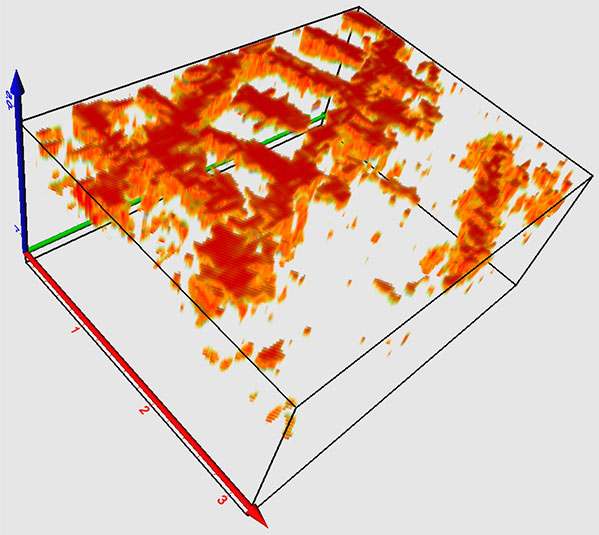oggin® 1000 GPR systems are regularly used for shallow, high resolution imaging on and around building infrastructure, but sometimes, during a survey, you may find something totally unexpected
During a recent GPR training course in Christchurch, New Zealand, everyone in the class, including the trainer, were shocked to find what was revealed by GPR. The class was learning how to set up and collect data with a Noggin® 1000 system using the SmartHandle configuration.
An empty warehouse near the training room was undergoing an extensive refurbishment after the severe earthquake that struck the area in 2011. The building owners allowed the class to use the open 20 x 30 meter warehouse area as a test site for the GPR training course.
The project started by collecting a few long reconnaissance lines across the floor in both directions to get a “feel” for the construction practice and reveal any large-scale anomalous areas (Figure 1). This showed that wire reinforcing mesh was present in less than half the floor. The line also revealed a strong hyperbolic response below the slab-on-grade concrete floor; initially interpreted at the time as a pipe or cable.

The next part of the training was grid collection so, based on what the reconnaissance lines had shown, a detailed grid survey was carried out over the “pipe”; a 3.2×4.2 meter (10.5×13.8 foot) with a 10 cm (4 inch) line spacing was quickly chalked out on the floor and collected in about 30 minutes (Figure 2).
Figure 2: The 3.2 x 4.2 meter grid was collected with GPR lines spaced every 0.1 m (10 cm) in both the X and Y directions; 76 lines with a total length of 276 meters. With a step size of 0.01m (1 cm), a time window of 20 ns (approximately 1 meter deep), and a time sampling interval of 0.1 ns, 27,620 traces and 5.5 million unique subsurface signal amplitude points were collected in about 30 minutes.

The grid data were processed and visualized as a series of depth slices using the SliceView module in the EKKO_Project software. In seconds everyone realized that the “pipe” interpretation was not correct. The 0.40 meter depth slice revealed there were two parallel, linear objects crossing underneath the warehouse floor (Figure 3).

Slicing deeper to 0.55 meters revealed linear features at equal intervals running between and perpendicular to the 2 parallel linear objects (Figure 4). Someone in the class suggested that it was a buried ladder until we used the SliceView Measure Tool to measure the width of the “ladder” at 1.15 meters and the distances between the “rungs” at 0.70 meters – an awfully large ladder!

Finally, someone suggested it looked like railroad tracks with ties between them. Sure enough, the measurements were consistent with the gauge of New Zealand railroad tracks. A couple of minutes later, a computer -savvy student hopped on the internet and found an old map in the Christchurch archives that showed a railroad track had once run through the area (Figure 5).

Once the interpretation of railroad track was made, a few other pieces of the puzzle fell into place. Not noticed initially during the data collection, but discovered after closer inspection of the reconnaissance lines, is the wire mesh-like response beside the strong “pipe” hyperbola. This mesh pattern can also be seen in the 40 cm depth slice (Figure 3). The mesh seems to be related to the railroad track, perhaps the concrete platform it rests on. The complete railway tracks, both rails and ties, is visible by plotting the grid data in 3D (Figure 6).

This survey just goes to show that, while many applications for GPR are routine (looking for buried pipes, cables and rebar), every now and then you find something you were not expecting. These situations are fun and exciting as they ignite the secret desire we all have to be detectives or archaeologists, and fill us with a strong sense of discovering of the unknown.
Story and Data Courtesy of Lord Civil, Christchurch, NZ
Click here to learn more about Noggin® Ground Penetrating Radar.








